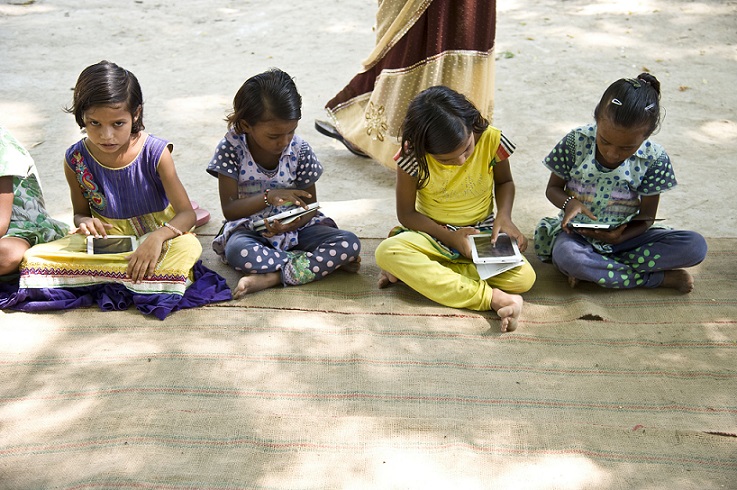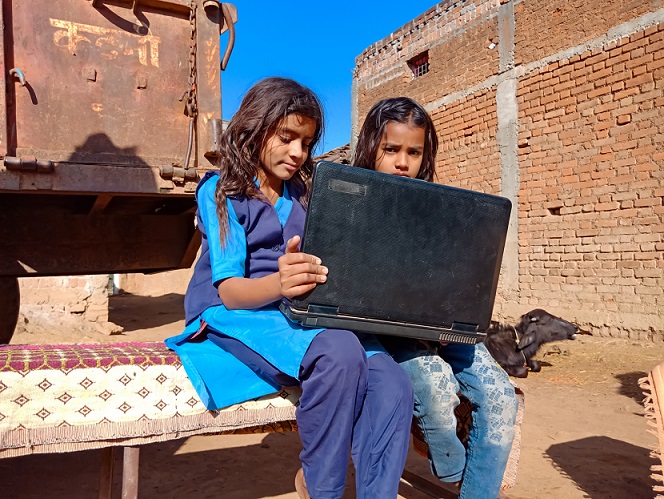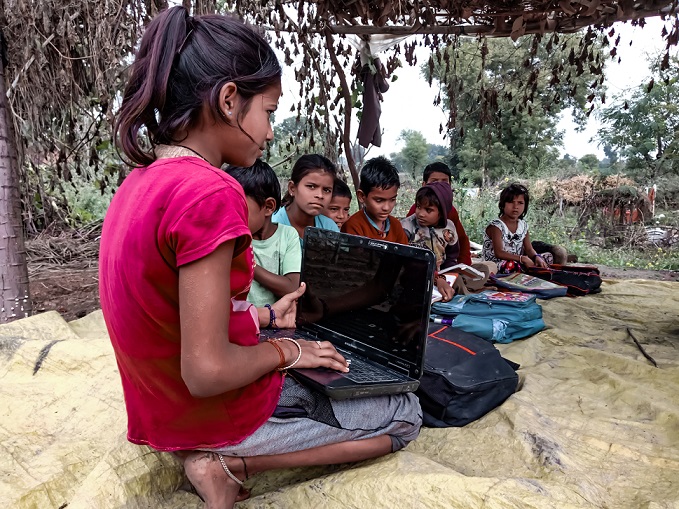Experts Predict 20% Increase in Girl School Dropouts. What Can We Do About It?
"Most of the girls from families of migrant workers are in the vulnerable age where they are likely to get married.”

Schooling screeched to a halt due to the COVID-19 pandemic, which took the world by surprise with little time to think about the changes required in the school curriculum. Educationists saw pedagogy compromised due to the absence of face-to-face classrooms, but indirect tutoring also posed a new set of challenges due to the inequality of access to the Internet in India.
The inequity in what one can deliver to students becomes glaring through the digital divide in teaching resources that students in rural India can access. In rural areas and urban slums, girls may not be as privileged as boys to have digital access, as a recent study shows.
“In India, girls are often excluded from access to technology,” say Lydia Marshall, Senior Education Researcher, and Rhiannon Moore, Education Research Officer, Young Lives, University of Oxford.
They add, “While digital access varies considerably by household wealth and location across India, there is a gender dimension to the inequality. Boys in India are much more likely than their female peers to use a computer and the Internet (as well as other forms of technology, such as a smartphone) regularly. Meanwhile, four in five (80%) girls in the Indian sample (based in Andhra Pradesh and Telangana) have never accessed the Internet, and more than three in five (62%) have never used a computer. Gender also interacts with other forms of disadvantage in India. Our data show that the poorest girls and those living in rural areas have much less access to technology than boys and girls in wealthier or urban households.”

Digital classrooms are challenging enough for developed countries like the USA and Sweden, leave alone India where development inequities exist.
Prof R Govinda, the Former Vice-Chancellor of The National Institute of Educational Planning and Administration (NIEPA), says, “Schooling is going to change after the pandemic due to academic losses suffered from long closure. Due to digital interventions, we are going to have to reduce human interfaces for rural areas in the future. Technology is for the rich or the middle class. There is no replacement for direct tutoring by a teacher in the class, and digital interventions cannot replace face-to-face tutoring. How do we plan to run the school during a long-lasting pandemic is a moot question. Do you want to run school through holding a phone in hand?”
India has the largest number of school-going children. Moreover, 41 per cent of the population is less than 18 years of age, nearly half of whom are girls.
Further, the largest number of children are under lockdown as most schools remain closed, and classes continue through various technologies viz. Interactive Voice Response, Community Radio, TV, WhatsApp, and various Internet platforms. State governments are using a wide range of apps for public schools. Despite the government’s efforts to launch apps to reach out to children in rural areas, education is interrupted, specifically for girls.
Prof Amita Rampal, Educationist, Delhi University, says, “It is estimated that about 20 per cent of girls are not going to come back to school after lockdown….most of the girls from families of migrant workers are in the vulnerable age where they are likely to get married.”
The shadow of COVID-19 looms large as the Matthew Effect is likely to set in for girls staying in rural areas and urban slums. According to this, those who start well in reading continue to do so, while those who do not are unlikely to catch up. The non-preference of digital access to girls will accentuate this impact, and girls will be left behind in the classroom. Unable to catch up due to the prolonged gap, they may be forced to drop out of school.

Education thinkers will quickly have to come up with solutions to bridge the gap in the gendered access to technology-based education.
UNTAD, in the report released on April 6, entitled ‘The COVID -19 Crisis: Accentuating the Need to Bridge Digital Divides,’ reveals that the pandemic has exposed the “wide chasm between the connected and the unconnected, revealing just how far behind many are on the digital uptake. Digitalization has also allowed schools to continue with some remote education activities. However, [the] capacity of students to benefit from remote teaching may be unequal due to different home-based access to Internet connectivity, different capacities of parents to support the children, as well as various levels of preparedness of schools in dealing with this challenge”.
Given the current crisis, this does not augur well for online classes for students who have gone back to their hometowns from metros and other big cities. In general, access to the Internet is important during these times. The gap is stark for some states in the country. Only 7-8 per cent of rural households have any access to the Internet in states like Bihar and West Bengal, which have a large number of migrant students. You can imagine the plight of girls trying to attend classes through a digital platform in these Internet-starved states.
We can find a local solution and use Panchayat broadband connectivity for regular virtual classes, maintaining physical distancing norms. Prof Govinda says, “Poverty-stricken, marginalised populations are going to be pushed further. I foresee a 20 per cent dropout from schools. The first ones to do so will be girls. The solution will have to be local, and the Panchayats will have to come forward on how to bring them back to the schools in their villages.”
Room to Read (RtR) is a global organisation transforming the lives of millions of children in low-income communities by focusing on literacy and gender equality in education. Founded in 2000 on the belief that World Change Starts with Educated Children®, RtR’s innovative model focuses on deep, systemic transformation within schools during two periods that are most critical in a child’s schooling–early primary school for literacy acquisition, and secondary school for girls’ education.
Sourav Banerjee, Country Director, Room to Read India, says, “It seems that a significant part of learning will need to happen at home during the pandemic, aided by parents, or technology, or both. Parents, therefore, will become important stakeholders in our education efforts. And we will need to quickly pivot our activities to address this ‘new normal’. Keeping the changed scenario in mind, Room to Read has developed digital educational material for children, teachers, and parents that can be distributed through cell phone networks. However, we need to ensure access to digital educational material for girls to avoid digital discrimination.”

#eSkills4Girls is an initiative launched by the G20 group of nations in 2018 with the aim to reduce the existing digital gender divide through increased access to technology, education, and employment opportunities particularly in low-income countries.
A notable example is the Lallapura Craft Cluster of Varanasi where traditional and entrepreneurial skills of rural women were boosted, enabling them to access more markets through the Internet.
Similarly, EQUAL Global Partnership aims to promote digital gender equality of women and girls by improving technology access, supporting development of STEM skills, promoting women’s leadership in ICT, and sharing data-driven research in support of this.
Women in rural areas are also getting digitally empowered through the government’s initiatives. Of note is the Pradhan Mantri Gramin Digital Saksharta Abhiyan, which aims to make one member in each rural family digitally literate. While e-pathshala provides educational resources for all students, Udaan provides free online resources to girls only of classes XI and XII.
Also Read: How This Govt School Principal Uses a 5-Step Plan to Teach Students During Lockdown
“Saathi”, a collaborative project between Google and Tata Trusts, has benefitted 25 million women in about 2.4 million villages in India with technology, smartphones, and Internet connections provided by Google. The saathis (friends) are rural women with basic literacy who are trained and equipped to educate other women in the use of Internet and social media tools with the help of local NGO partners. Over a six-month period, each saathi must train at least 600 women from 2-3 villages.
The global and local efforts should be in sync. Efforts like that of #Eskills4Girls, EQUAL, Saathi Projects, and Udaan are laudable efforts to minimise the digital gender divide. While access to the Internet and the availability of cheaper digital devices for girls in rural areas is crucial, the question remains on how to empower girls to use digital devices.
(Edited by Shruti Singhal)
Like this story? Or have something to share?
Write to us: [email protected]
Connect with us on Facebook and Twitter.
If you found our stories insightful, informative, or even just enjoyable, we invite you to consider making a voluntary payment to support the work we do at The Better India. Your contribution helps us continue producing quality content that educates, inspires, and drives positive change.
Choose one of the payment options below for your contribution-
By paying for the stories you value, you directly contribute to sustaining our efforts focused on making a difference in the world. Together, let’s ensure that impactful stories continue to be told and shared, enriching lives and communities alike.
Thank you for your support. Here are some frequently asked questions you might find helpful to know why you are contributing?


This story made me
-
97
-
121
-
89
-
167











